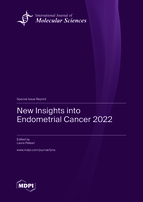New Insights into Endometrial Cancer 2022
A special issue of International Journal of Molecular Sciences (ISSN 1422-0067). This special issue belongs to the section "Molecular Oncology".
Deadline for manuscript submissions: closed (25 December 2022) | Viewed by 26146
Special Issue Editor
Interests: cancer prevention; molecular biology; drug repurposing; health technology assessment; pharmacoeconomics
Special Issues, Collections and Topics in MDPI journals
Special Issue Information
Dear Colleagues,
Endometrial Cancer is a hormone dependent cancer with an increasing incidence that is estimated to growth in the next years. It is typically treated with surgery and/or chemo/radiation therapy. Recently, it has been demonstrated the clinical benefit of hormone therapies for advanced and recurrent Endometrial Cancers underlined the need to examine their characteristics (particularly steroid hormone receptors expression and functions) to assess their better use. Furthermore, a critical phase to drive the clinicians in the therapeutic choice is the histopathological and molecular classification. In fact, an even current challenge is to integrate IHC markers with molecular tests to identify prognostic groups. Moreover, the observations of the immunosuppressive nature of endometrial cancer environment are leading to promote studies to assess therapies aimed to boost immune response that might represent a significant potential in the disease treatment. For this reason, current and ongoing studies are trying to improve clinical responses through immunotherapies strategies combined or not with classic treatments.
This open-access Special Issue will bring together original research and review articles on molecular oncology with attention to endometrial cancer. It highlights new findings, methods, and technical advances in molecular cancer research. The main feature of this Special Issue is to provide an open-source sharing of significant works in the field of molecular oncology that can increase our understanding of endometrial cancer development, which may lead to the discovery of new molecular diagnostic technologies and targeted therapeutics.
Topics include but are not limited to: Molecular methods to personalize endometrial cancer screening and detection; Identification and new aspects of cellular signaling molecules and pathways for target discovery, drug design, personalized and gender medicine; DDI discovery in endometrial cancer management; Drug repurposing for endometrial cancer prevention/treatment; Molecular modeling studies.
Dr. Laura Paleari
Guest Editor
Manuscript Submission Information
Manuscripts should be submitted online at www.mdpi.com by registering and logging in to this website. Once you are registered, click here to go to the submission form. Manuscripts can be submitted until the deadline. All submissions that pass pre-check are peer-reviewed. Accepted papers will be published continuously in the journal (as soon as accepted) and will be listed together on the special issue website. Research articles, review articles as well as short communications are invited. For planned papers, a title and short abstract (about 100 words) can be sent to the Editorial Office for announcement on this website.
Submitted manuscripts should not have been published previously, nor be under consideration for publication elsewhere (except conference proceedings papers). All manuscripts are thoroughly refereed through a single-blind peer-review process. A guide for authors and other relevant information for submission of manuscripts is available on the Instructions for Authors page. International Journal of Molecular Sciences is an international peer-reviewed open access semimonthly journal published by MDPI.
Please visit the Instructions for Authors page before submitting a manuscript. There is an Article Processing Charge (APC) for publication in this open access journal. For details about the APC please see here. Submitted papers should be well formatted and use good English. Authors may use MDPI's English editing service prior to publication or during author revisions.







